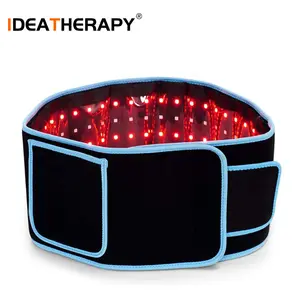The fat belt is a bespoke accessory crafted to bolster individuals on their quest for weight reduction. This device zeroes in on the midriff, amplifying the impact of exercise and fostering a more defined silhouette. Concentrating on diminishing abdominal adiposity, the fat belt stands as a cutting-edge adjunct for those aspiring to refine their waistline.
Assortment of Fat Belts and Their Attributes
A vast array of fat belts saturates the market, each customized to meet distinct needs and tastes. For example, the weight loss belt for the stomach typically incorporates thermal attributes to intensify perspiration. Conversely, a belly fat burner belt may employ electrical impulses to more precisely engage the stomach muscles. Moreover, weight belts for weight loss often serve a dual purpose as support garments, offering spinal reinforcement and contributing to better posture. The tummy belt for weight loss is usually more discreet, designed to be worn unseen beneath attire, catering to those who prefer privacy. Each variant is thoughtfully engineered to tackle various facets of weight reduction and body contouring, from simply boosting thermal activity to providing muscular stimulation and structural support.
Design and Functionality of Fat Belts
The architecture of a fat belt reflects the innovation underpinning its conception. A prototypical belt may boast a layered make-up: an inner stratum that is plush and moisture-wicking, an intermediate layer embedded with heat-retaining materials, and a sturdy exterior that preserves the belt's form and longevity. The operational principle is uncomplicated yet efficacious; by fastening the belt snugly around the waist, it exerts mild pressure and warmth to the region, potentially aiding the thermogenic process and offering support. Some belts come with added features like gel inserts for thermal therapy or compartments for personal electronics, augmenting their practicality and allure.
Comprehensive Review of Materials in Fat Belts
The selection of materials for fat belts is intentional, striving to strike a harmony between effectiveness and comfort. Polyester and nylon are preferred for their durability and elasticity resistance. Spandex is incorporated for its flexibility, enabling the belt to mold to the wearer's physique. Cotton might be included for its hypoallergenic qualities and gentle feel, reducing the likelihood of abrasion or skin reactions. These substances are typically interwoven into a composite textile that maximizes the belt's performance—intensifying the sauna-like effect for weight loss while ensuring the belt remains airy and agreeable, even amidst strenuous exercise.
Commercial Utilization and Applications of Fat Belts
Fat belts have carved out a niche in various commercial spheres, especially within the wellness and fitness sectors. Health clubs and gymnasiums stock them as merchandise, tapping into the burgeoning trend of wearable fitness tools. In corporate wellness initiatives, these belts are gaining traction as firms seek novel methods to motivate staff towards healthier habits. They are also a staple in physiotherapy practices, where they bolster rehabilitation and weight management regimens. By integrating fat belts into their offerings, enterprises can deliver enhanced value to their patrons, championing not just weight loss but holistic health.
Roles of Fat Belts
The fat belt fulfills several roles. Primarily, it serves as an adjunct to weight loss, augmenting the body's innate warmth during physical exertion to escalate sweat production and caloric expenditure. It also acts as a supportive garment, providing compression that can stabilize the core and ameliorate posture while exercising. For those suffering from back discomfort or past injuries, the belt offers a measure of support that can render physical activity more manageable and secure. Additionally, certain belts with integrated stimulators perform a therapeutic role, softly kneading the abdomen to ease pain and encourage muscle relaxation.
Characteristics of Fat Belts
Notable characteristics of fat belts encompass their adjustable fastenings, which permit users to tailor the fit as their physique evolves. Numerous belts also incorporate anti-slip interiors to maintain position during dynamic movements. Some sophisticated models are fitted with intelligent features, such as sensors that gauge core temperature and monitor progress over time. These attributes not only refine the user experience but also yield concrete metrics that can inspire and steer users towards their fitness objectives.
Advantages of Employing Fat Belts
The advantages of employing a fat belt go beyond mere cosmetic enhancements. Users frequently experience an uptick in core firmness and a decline in back pain, attributable to the belt's supportive design. The warmth generated by the belt can also provide a comforting effect on muscle aches, rendering it a multifaceted instrument for both fitness and recuperation. Furthermore, the psychological uplift from witnessing tangible improvements can significantly influence a user's dedication to their health and fitness regimen.
Optimizing the Use of a Fat Belt
To optimize the benefits of a fat belt, one should don it either directly on the skin or atop a slim layer of clothing to facilitate proper heat generation. It is crucial to adjust the belt to a snug yet comfortable compression that does not impede breathing or motion. For optimal results, the belt should be employed during physical activities that elevate the heart rate and induce perspiration, such as cardiovascular or resistance training.
Selecting an Appropriate Fat Belt
Choosing a suitable fat belt entails evaluating personal objectives and predilections. For those desiring to boost workout efficacy, a belt with thermal capabilities may be optimal. If spinal support is a concern, a belt with a broader back panel and more robust compression could be the superior option. It is also wise to consider the maintenance ease and material robustness, ensuring the belt can endure regular usage and cleansing.
Care and Upkeep of Your Fat Belt
Meticulous maintenance is essential to preserve the functionality and lifespan of a fat belt. Most belts can be cleansed with a moist cloth and gentle detergent, then left to air dry away from direct sunlight. It is imperative to eschew abrasive chemicals and heat sources that could compromise the materials. Periodic checks for wear and tear can preempt potential complications during usage.
Intended Demographic for Various Fat Belts
The intended demographic for fat belts is wide-ranging, encompassing anyone eager to amplify their exercise regimen or advance their weight loss ambitions. This includes new parents striving to reclaim their pre-baby shape, office workers aiming to mitigate sedentary lifestyle impacts, and workout aficionados intent on maximizing their training. Each product iteration is conceived with the end-user in mind, ensuring that, regardless of casual or intensive use, there is a fat belt to suit their requirements.
Discover the extensive array of fat belts on Alibaba.com, where businesses can source premium products tailored to the diverse needs of their clientele.










































 浙公网安备 33010002000092号
浙公网安备 33010002000092号 浙B2-20120091-4
浙B2-20120091-4